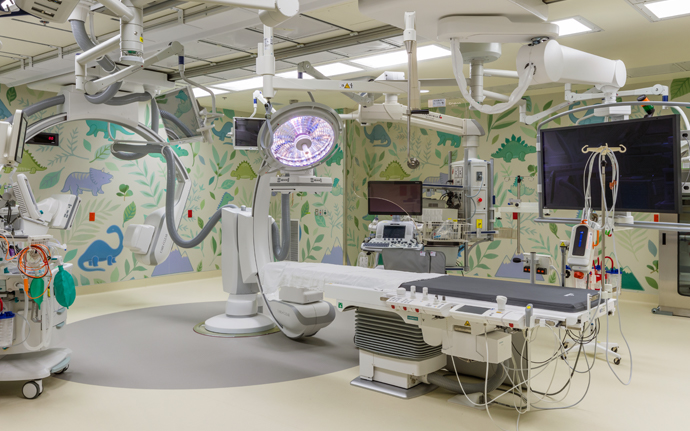Staying ahead of the curve
For Dan DeBeyer and Susan Tees, BC Children’s Hospital is like a second home. The family has made countless trips ever since their three boys were born with congenital scoliosis, a severe curvature of the spine, and underwent an innovative procedure in which a rod was inserted into their backs.
Malcolm, 17, William, 14, and James, 9, come to the hospital every few months to have their rods expanded as they grow. But when Malcolm came for his last surgery, it wasn’t like the other times.
It was better.

A new experience
Since the Teck Acute Care Centre opened its doors in late October, a lot has changed. That’s noticeable the moment kids and families arrive for surgery. In the old building, they would check in, have their assessment, and then wait in a noisy playroom filled with other anxious families. Space constraints also meant that they might be seen by some health providers in that room.
“When we designed the new hospital, we wanted to create something better for our families. So, we made sure every child gets their own private room.”
— Trish Page, Procedures Services Program Manager, BC Children’s Hospital
That brings a host of benefits: privacy, confidentiality, infection control, and as Dan adds, it goes a long way in reducing stress.
“It used to be really hard to hear other parents or kids in distress. The private rooms give us quiet space as we experience our toughest moments.”
Putting kids first
Every inch of the building has been designed to put the needs of kids first—and that’s especially visible in over 300 pieces of purposeful artwork that cover the walls. As kids are being wheeled down the long hallways to the operating rooms, murals illustrating diverse landscapes from across BC remind them of home or places they’ve been. Even the operating rooms are covered in art designed to calm anxious minds.
It can also promote a child’s recovery, since patients usually wake up from anesthesia in the same state they went to sleep in.
“A more settled pre-op experience can lead to better pain management and even shorter stays,” Trish explained.
The healing power of family
In the old anesthetic care unit, patients would be brought to the recovery room after surgery—a space with beds separated only by curtains. As they woke up, they’d be surrounded by other kids who were distressed, sometimes crying. Machines for each patient beeped constantly, making the waking process more stressful. Now, they wake up in their own private room filled with natural light. That also means parents can be brought in sooner than ever before.
“Before, there were times when we couldn’t get parents in as quickly because of something that was going on with the neighbour patient, for example,” explained Karen Sokalski, a clinical nurse coordinator. “Now that we have private rooms we don’t have the next door neighbour factor delaying the parents.”
Room to grow
The new procedures unit is built to ensure BC Children’s stays at the forefront of pediatric surgery for years to come. More space and a smarter design mean operating rooms can grow, the latest technologies can be incorporated, and kids can be treated sooner—which Trish says “wouldn’t have been possible without the building.”
Dan and Susan also agree that the new hospital has transformed their experience.
“Our kids now have privacy as they recover and we have the ability to be with them the whole way,” Dan said. “That’s huge for us.”
Surgeries in the Teck Acute Care Centre
Since the facility opening in October, there have been…
- over 4,500 surgical procedures
- shortest procedure: 7 minutes in Ophthalmology
- longest procedure: 13.7 hours in Neurosurgery
- youngest patient: 0 days; three newborns have had surgery the day they were born
- oldest patient: 20 years; while rare, we can perform procedures on young adults to offer a better continuum of care
